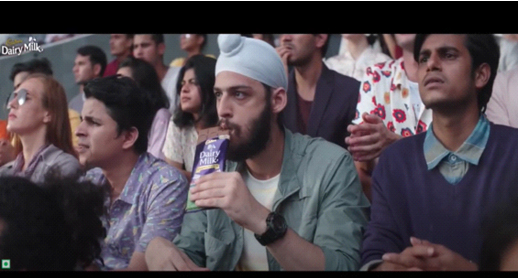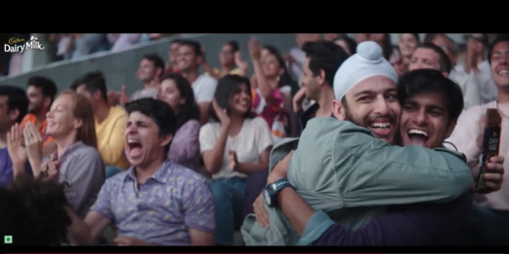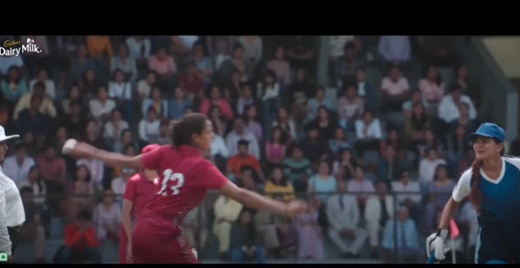Identification of Myths: A Comparative Semiotic Analysis of 1994 and 2021 Cadbury Advertisements using Ronald Berthes’ Semiotic Theory
Chitralekha Agrawal[1]
Sayan Dey[2]
Abstract:
The new Cadbury chocolate role-reversal advertisement, which was launched on September 17, 2021, is an imitation of a three-decade-old campaign for the same company, with the characters’ gender roles switched around this time. The researchers conduct a comparative analysis of both advertisements using Ronald Barthes’ semiotic theory to find out which symbols have been embedded in the audio-visual text of the ad films to mimic the contemporary socio-cultural state of India. The important visual and verbal indicators that carry social meanings have been identified through the interpretative qualitative analysis of signifier and signified. The findings conclude that, in contrast to the previous advertisement, which depicted gender roles in traditional socio-cultural contexts in India, the new advertisement promotes equality and celebrates female empowerment, shattering preconceived notions about gender.
Keywords: Cadbury ad, semiotic analysis, Roland Barthes, role reversal, gender equality.
Introduction:
Advertising is an applied mass medium that holds the key to understanding both the form and substance of modern mass communication (Kumar, 2015: p. 401). Since it is a persuasive medium that is used to communicate information about a product, service, or idea and to promote its sale, every advertisement is carefully crafted to appeal to people and have an impact on their purchasing behaviour (Belch et al. 2014). Due to its audio-visual capabilities and ability to influence people, television is a suitable medium for featuring ads (Dwita&Wijayani, 2018). It is well established that watching audiovisual advertisements on television can have psychological and emotional effects on viewers (Todua, 2011). The use of narrative by advertisers helps them reaches more people. According to studies, advertising’s use of storytelling has a higher effect on customers and strengthens their connection to brands (Kang et al., 2020). Through the use of well-known symbols and signs that draw inspiration from the local culture, the story is constructed. These symbols have connotative and denotative meanings (Barthes, 1957). Connotative meaning is the associative meaning that a consumer constructs based on their cultural and societal references, as opposed to denotative meaning, which is either a literal meaning or has a physical likeness to the sign (Barthes, 1957). As a result, all advertising uses symbolic cultural codes to construct its messages so that consumers may decode them and understand the underlying meaning. Additionally, it is very typical for advertisers to assign special significance to particular individuals, occasions, or traits that foster preconceptions or stereotypes in the minds of consumers.
The present study conducts a comparative analysis of two Cadbury advertisements that have an identical storyline and were released in the media in two different time periods: 1994 and 2021. The only difference the 2021 ad has is that the roles of male and female protagonists have been reversed this time. As Cadbury chocolate advertisements are known for the specific cultural codes that are featured in them and that instantly connect these ad films with the audiences, they make for an ideal sample to analyse the contemporary socio-cultural messages and symbols embedded in them.
The objectives of the study include the following:
- To examine how the advertisements, use verbal, iconic, and encoded signs and symbols.
- To evaluate the usage of signs and symbols in both commercials in order to draw comparisons.
- To determine whether the new advertisement supports certain myths those are pervasive in Indian society today.
1.2 Conceptual Framework:
The conceptual framework of the study is based on Ronald Barthes’ semiotic theory and interpretation of signs. Berthes introduced the idea of “myth.” Myth, to put it simply, is a form of communication that uses signs and symbols to express ideas (Barthes, 1957). They could be nonverbal visual signals, vocal or linguistic cues, or both. They serve as a means of communicating with others (Barthes, 1957). In order to explain the myths, he used Ferdinand de Saussure’s concepts of “signified” and “signifier” (Hatam& Al-Ghabra, 2021). The signifier is a verbal, visual, or auditory denotative symbol that designates a random concept (the connotation). The association between the denotation and the connotation is the ‘sign’. This is called the first-order system. According to Hatam and Al-Ghabra (2021), Barthes used the concept of myth to create a “second order system” in which a first order system’s sign serves as the signifier for another sign. A “scale,” which is a signifier, for instance, denotes the “idea of measurement.” When this first order sign denotes another meaning, it turns into a “myth.” In another context, it might denote “justice,” for instance (Hatam& Al-Ghabra, 2021). A sign’s interpretation is arbitrary since language serves more than one purpose, including conveying abstract ideas that are significant to a culture (Chandler, 2005). A myth acts in accordance with a particular dominating stream of ideas and has the function of making these concepts seem natural (Griffin, 2009). Popular concepts are stripped of their true meanings by myths, which then repackage them with new and frequently very different socio-cultural implications (Cobley&Jansz, 2004).
2. Review of Literature:
Many researchers in the past have utilised Barthes’ semiotic analysis as a popular technique to decipher the current myths and socio-cultural messages ingrained in the visual and vocal texts of commercials. Sahu and Heathy (2019) investigated the feminine myths embedded in the cosmetic advertisements, while Selvam and Lakshmi (2016) highlighted how Indian ad films started to reflect the financial independence that occurred in the country’s middle-class women. Prathas& K (2019) performed a structural analysis on a few Cadbury advertisements to determine how signs and symbols are being used to promote western culture. Jha et al. (2017) studied magazine advertisements to conclude how femininity has been depicted as sexual objects. Semiotic analysis was employed by Sharma and Gupta (2015) to examine the advertisements that appeared on Indian television. Many scholars outside India have also studied the use of symbols in advertising films to mimic the socio-cultural condition of a society. Dwita and Wijayani (2018) used Barthes’ ideas to examine the themes about gender equality in the Indonesian ‘Fair and Lovely’ advertisement. Denotative and connotative socio-cultural connotations were found in Purba and Tambunan’s (2021) analysis of another Indonesian advertisement. Camille (2022) recently investigated how the well-known Cadbury ad from 2007 with the gorilla successfully communicated joy and happiness. Mortelmens (1998) performed a socio-semiotic examination of luxury product print advertisements to determine how the majority of these ads convey the idea of luxury.
3. Materials and Methods:
In this investigation, two Cadbury audio-visual advertisements were employed; the first was launched in 1994 and the second on September 17, 2021. The new advertising has the same plot, melody, and theme, but the protagonists’ gender roles are now reversed. The study compared the textual and visual symbols employed in the two commercial videos using Ronald Berthes’ semiotic analysis methodology. The study was carried out using the qualitative interpretative methodology on three levels: 1. analysis of linguistic signs or verbal texts; 2. analysis of iconic symbols or denotative messages; and 3. Analysis of encoded signs and symbols to understand connotative meanings embedded in the films.
4. Analysis:
Context of ad: Celebration of a victory that is conveyed through the premise of a cricket match.
Story: The original advertisement tells the tale of a cricket player who is on 99 and about to face the game’s final ball, which would determine the contest’s outcome. A beautiful and contemporary girl who is the friend of the batsman is munching on Cadbury dairy milk chocolate in the pavilion. The atmosphere is tense. The batsman hits the bowler’s ball close to the boundary. As the fielder chases the ball in an attempt to capture it, the spectators in the stadium believe that the player missed it. The fielder fails to make the catch, as the ball sails over the boundary for a six. The stadium is in a frenzy. Everyone starts to applaud and celebrate. The player’s pal was ecstatic. She leaps into the field while dodging the security and dances there joyfully. Later, she visits the batsman, gives him a hug, and they share a Cadbury chocolate bar. In the new commercial, the same plot is presented, but the characters’ roles have been switched to emphasise gender equality. Now that it’s a women’s cricket match, the player’s male companion, a contemporary Sikh, leaps onto the field in celebration when his female friend scores a six and triumphs. She hugs him after accepting the Cadbury chocolate from him.
Table #1: A comparative analysis of the Old and New advertisements:
| Cadbury Ad 1994 (36 second) | Cadbury Ad 2021 (40 second) |
| Context: Cricket match (domestic) | Context: Cricket Match (domestic) |
| Jingle: Kuchh Khas hein Hum Sabhi Mein, KuchhBaathein hum sabhi Mein. Baat Hain, Khaas Hain, KuchhSwaad Hain Zindghimain..(We all have something special in us. Life has a distinct taste) | Jingle: Same jingle with same music notes |
| Weather: Sunny day | Weather: Cloudy day |
| Player: A fair, Chubby man | Player: A dusky woman who sports a nose-pin |
| Coach: A man | Coach: A woman, Jercy no 9 |
| Bowler: A man, right hander, jercy number not shown. | Bowler: A women, left hander, Jercy no 13. |
| Colour of players’ dress :White (Both sides) | Colour of players’ dress: Blue (batting side) Red (balling side) |
| The Friend: A woman who is
• Spirited woman: Represented through her actions • Modern: Represented through her dress (dons a vibrant frock and accessories) • No religious symbol was used. |
The Friend: A man
• Spirited man: Represented through his actions • Modern: His outfit (T-shirt, Jacket & Trousers) & accessories (Broad strap sports watch in right hand. • Religious symbols used to establish him as a Sikh man: Turban on head, beard on face and Kada(Bangle) in left hand. |
| The field side where the girl jumps: Many pigeons can be seen there | The field side where the man jumps: No pigeons. |
| Towards the end: The woman offers chocolate to the batsman & hugs him. | Towards the end: The woman eats chocolate apparently offered by her friend & hugs him. |
| Ending Scene: The woman hugs the man & at the bottom appears the tagline: “AsliswadZindghi ka (real taste of life)” | Ending Scene: The Woman Hugs the man and at the left side appears: #GoodLuckGirls |
| Tagline: AsliSwadZindgi ka, Appears in last scene; both as written text and as voice over. | Tagline: KuchhMeetha Ho jaaye, KuchhAchchha ho Jaye, appears as the written text on the additional graphic plate that shows Cadbury chocolates. The graphic plate appears just before the ending visual. |
| Cadbury Logo: No Cadbury logo in the running duration of ad except in the final visual. | Cadbury Logo: An additional Cadbury Dairy Milk logo was shown throughout the film at the upper left hand corner. |
Table#2 Comparison in the semiotics of the key visuals of both the ads:
- Visual#1: Protagonist : The Player
 fig.1aSignifier 1: A man in jersey.Signified: A cricketer • Connotes an ordinary cricketer.
|
 fig. 1bSignifier: A woman on batting side on field, in blue dress, Sporting a nose pin, Dusky Complexion.Signified: A dark complexioned & traditional woman cricketer who represents India now. • Connotes a modern girl who is both traditional (shown through nose-pin) and bold enough to play cricket which is conventionally a men’s game. |
| Signifier 2- The room behind the batsman is small. A wicket keeper can be seen nearby. The closed shot focuses on the man who bats.
Signified: The world is narrow. |
Signifier 2- Broad view behind the batswoman. Fielders as well as the pavilion can be seen. The wide shot shows focus on the woman as well as the world behind
Signified: The world is broad with broad overview. |
- Visual#2: The friend
 fig. 2aSignifier 1: A Woman with loose hair, a vibrant western dress & chunky earrings& colourful hand-bandSignified: A modern woman. |
 fig.2bSignifier: A man with Turban. Sports watch in right hand &Kara in left hand. Signified: A modern Sikh man. |
| Signifier 2- The room behind the woman is small.
Signified: focus is on the woman. She stands out. |
Signifier 2- broad view behind the man. Many viewers can be seen. The wide shot signifies focus on the protagonist as well as the other people in the man.
Signified: The coexistence. |
Visual#3: The Act: Dance
 fig. 3aSignifier 1: The woman jumps the fence and dances on groundSignified: Joy, Exhilaration. Symbolically signified: The free thinking & modern woman- different from traditional Indian women, who does not hesitate to enjoy the moment. |
 fig. 3bSignifier 1: The man jumps the fence and dances on groundSignified: Joy, Exhilaration. Symbolically signified: The broadminded present day Sikh man who does not hesitate to support his friend openly. |
|
| 2. | Signifier 2- Pigeon on ground
Signified: Cleaner environment |
Signifier 2: Empty Ground
Signified: Not so clean environment. |
- Visual #4: Final Scene
 fig 4aSignifier 1: The Woman Hugs the Batsman first and leans his shoulder and both enjoy the chocolate.Signified: • Bonding of a couple. • Both genders portray their traditional roles: woman brings chocolate to man to greet him on his victory. |
 fig. 4bSignifier 1: The Batswoman Hugs the man. Woman is leaning on man’s shoulder. Alongside #GoodluckGirls appears on screen.Signified: • Bonding of a couple. • Man and woman don’t portray traditional roles. Man brings chocolate to his woman friend on her victory. • Caption denotes the trending hash-tag of micro-blogging site. The connotative meaning of the caption is ‘New Trend’ and new advanced social media world. |
| Signifier 2- A fair man & fair woman
Signified: coexistence of same. |
Signifier 2: A fair man & A dusky woman.
Signified: Co-existence of opposites. |
- Visual#5 : Left Right Orientations & Jersey No 13
 fig 5aSignifier1: Woman in old ad turns right to hug her friendSignifier 2: The Man bowler is right handed Signifier 3: The Batsman plays from the right side Signified: The Symbolic Signifier signifies traditional orientation which is from left to right. |
 fig 5bSignifier1: Man in new ad turns left to hug her friendSignifier 2: The female bowler is left handed Signifier 3- The Female player in new ad plays from left side Signified: Non conventional values are signified. Orientation towards left symbolises liberal values. |
 fig 5cNo jersey number is shown. |
 fig 5dSignifier 4- Woman bowler wears jersey No 13.Signified: Symbolically No 13 signifies sufferings & bad luck. Signifier 5: The girl hits the ball thrown by Jercy No 13 girl, to the boundary. Signified: The woman today can face the sufferings & odds boldly. |
Findings and Discussion:
The examination of both advertisements reveals that the narrative has been skilfully crafted with a subtle use of signs and symbols to allude to the socio-cultural values and ideology of the era in which they appear (see table #1). The old movie depicts both men and women in their traditional roles and, by fusing various symbols, creates the myth of modern men and women (see fig. 1a and fig. 2a). The idea of a woman playing a “supportive role” has been linked to modernity through the denotative use of women’s clothing and appearance and a carefree attitude shown by showing her dancing on the field. It created a new myth about a modern, carefree woman who assumes the role of a traditional Indian woman and stands by her man. The myth of masculinity was also created by fusing the symbols of power (the cricketer), sweetness (the man’s soft features), and traditional values that have been represented by his ‘blush’. The myth of a modern, successful man in the old movie is a classic, patriarchal concept that is strong, traditional, conventional, manly, and open about the public display of love. The concept is different from a man’s stereotypical ‘rough and tough’ masculine image.
The examination of the symbols demonstrates how the myth of girl empowerment has been established by the use of signs in the new role-reversal campaign, in line with Berthes’ (1957) theory that myths are created by assigning a different meaning to a sign and creating a second-order signification. The depiction of a female cricket player with a nose ring suggests a traditional Indian woman who respects her roots while also being strong and courageous enough to overcome obstacles (see Fig. 1b). The concept of the empowered Indian woman has been given a new social construction through the employment of the denotative signs of cricket, woman, and nose ring. The symbols of a man with a religious identity, such as a beard, turban, and bangle, have been used to build yet another myth of contemporary masculinity (see fig. 2b). The additional signs that he is a modern, educated man are his fashionable clothing and large watch dial. His “dance of delight” represents a contented and encouraging man who doesn’t hold back from openly rejoicing over his friend’s success (see fig. 3b). The idea of a modern man who is assertive, rooted in his heritage and religion, and supportive of women is created when all the indications are taken together.
We may see how both advertisements contributed to the creation of gender myths if we examine how female protagonists are portrayed in the two ad films. The outdated stereotype of a modern woman is one who is attractive (fare colour and sharp features), upbeat, and confident (see Fig. 2a). The traditional definitions of beauty, which include fair skin tone and angular features, have been used to demonstrate beauty, while her outfit and dancing have been used to demonstrate modernism and audacity. In contrast to the previous advertisement, the new one creates the mythological beauty of a woman by fusing assurance, a dark complexion, and a classic nose ring (see Fig. 1b). This contemporary woman is unconventionally attractive and deeply anchored in her culture. The same observations can be made in the case of male protagonists. The old film’s man is devoid of any religious identity and has a bold attitude, while the new man represented in recent advertisements is a modern Sikh man who is cheerful and bold. The old man blushes, while the new unconventional man has no reservations about showing off his happiness publicly (see Fig. 3b).
In contrast to Indians’ left-to-right orientation, other symbols utilised in the advertisements display a ‘right-to-left’ direction (see figs. 5a and 5b). The use of the number 13 (see Fig. 5d), a bad omen symbol, on the bowler’s jersey, whose ball was hammered for a six by the female cricketer, suggests that today’s ladies are resilient enough to overcome obstacles or bad omens that stand in their way. There is another argument on the sidelines. The number 13 is associated with bad luck and shunned by people across the globe. In many hotels, room number 13 is often missing by design. However, in Sikh religion, number 13 is associated with god. It is pronounced “Tera’ (in English, it means “yours”). The Gurus used “yours” to refer to Waheguru and the Creation that includes us all. As the male protagonist is a Sikh youth, the ad probably made yet another point about shunning superstition! Once again, a common symbol is used to create the story of a powerful woman. According to Dwita and Wijayani (2018), myth is not a benign or neutral symbol but rather a marker for plays that convey particular messages that may be very different from their original intent. The myths constructed in the role-reversal advertisement describe the ideological significance that prevails in today’s Indian society.
Conclusion:
The semiotic study of both advertisements reveals that the new Cadbury advertising focuses on modern social narratives. The constructivist paradigm was utilised by the ad creators to give signs second-order significance. This advertisement promotes gender equality, yet it also perpetuates stereotypes about what a modern man and woman should be like by creating gender myths. Other indications, such as liberal culture and equality for all social groups regardless of tradition, religion, colour, or caste, have also been subtly employed to fit current narratives. A comparison of the two advertisements demonstrates how storytelling symbols evolve over time to reflect modern views and trends and how myths are created to suit the dominant ideology of a certain period.
References:
- Anisimova, T., Mullern, TG (2014) Popular Music in Audio-Visual Advertising: A Study of the Roles and Functions of Lyrics in TV-Commercials. Advances in Social Sciences Research Journal1(5):8-21. DOI: 14738/HYPERLINK “http://dx.doi.org/10.14738/assrj.15.268″assrj.15.268
- Barthes, Ronald (1957) France: Les Lettresnouvelles.
- Belch et al. (2014) Advertising and Promotion An Integrated Marketing Communication Perspective. India: McGraw Hill Education
- Cadbury Advertisements. Accessed on 31 July 2022 at URL:
- Camille, Patrice (2022) A Glass and a Half Full of Joy Campaign Analysis. edu. Find at URL: https://www.academia.edu/8569703/A_Glass_and_a_Half_Full_of_Joy_Campaign_Analysis
- Chaco, Benita. 2021, Following Piyush Pandey’s advice, the boy’s dance moves were kept unrehearsed to look spontaneous: Ogilvy’s creative team behind new Cadbury ad, Afqas.com article, Pub on Sep 20, 2021. Find at URL: https://www.afaqs.com/news/advertising/following-piyush-pandeys-advice-the-boys-dance-moves-were-kept-unrehearsed-to-look-spontaneous-ogilvys-creative-team-behind-new-cadbury-ad (accessed on October 13, 2021)
- Chandler, D. (2005). Semiotics for Beginners. Retrieved July 22, 2009 from
- Cobley, P., Jansz, L. (2004). Introducing Semiotics. (2nd ed.). Singapore: Tien Wah Press Ltd.
- Dwita, D., Wijayani, I (2018) Gender Equality in Media Television (Semiotic Analysis of Fair and Lovely Advertisement Issue of Marriage or Master Degree). Komuniti 10 (1). Maret 2018
- Griffin, E. (2009). A First Look at Communication Theory. (7th ed.). New York: McGraw-Hill.
- Hatam, S., Al-Ghabra, IMMM HYPERLINK “https://www.researchgate.net/profile/Iman-Muwafaq-Al-Ghabra?_sg%5B0%5D=3–FMYmoosIXEhUPuXo0xr-_77YAZb4KWDS_KnBiDeRB-IkCNtFERWgvZZywyzFVsd2_Z8c.5pDtwaxDe8SRUcJNk6jIoJto_NYzJ_hzNU6tYle_AaXvKxWooZac1UWYxxK9yfzw8IO61txeeWvdYCR8kmEIPg&_sg%5B1%5D=qEV2Khgf7tZGPGgiuDYd4gozfRR72QTnZM0HIc2Bx3CNBtDOS8_ZUCQZxUsSS35LWgpNXEM.KcT9m8z3wwrAOgiz0ekhYVun8VMDkk8f_T8W3SqY-lRikVmO25HYcZ-bbx05Q_rfgKSwe92JKsvl8e4Xgximyw” (2021) Barthes’ Semiotic Theory and Interpretation of Signs. International Journal of Research in Social Sciences and Humanities 11(3). DOI: 37648/ HYPERLINK “http://dx.doi.org/10.37648/ijrssh.v11i03.027″ijrssh.v
- Jha et al. (2017) A Semiotic Analysis of Portraying Gender in Magazine Advertisements. IOSR Journal Of Humanities And Social Science (IOSR-JHSS) 22 (5):1-8
- Kang et al. (2020) The role of storytelling in advertising: Consumer emotion, narrative engagement level, and word-of-mouth intention. Journal of Consumer HYPERLINK “https://www.researchgate.net/journal/Journal-of-Consumer-Behaviour-1479-1838″Behaviour 19(1):47-56. DOI: 1002/ HYPERLINK “http://dx.doi.org/10.1002/cb.1793″cb.1793
- Kumar, KJ (2015) Mass Communication in India. Delhi: Jaico. 401
- Mortelmens, Dimitri (1998) Socio-semiotic analysis of print advertisements for luxury products. Find at URL:https://www.academia.edu/29285852/Socio_semiotic_analysis_of_print_advertisements_for_luxury_products
- Prathas, P., K., Sreena (2019) A Neo-Colonial Indentation in Advertisement: A Structural Analysis on Selected Cadbury Chocolate Advertisement. International Journal of Innovative Technology and Exploring Engineering (IJITEE) 8 (7C). Blue Eyes Intelligence Engineering & Sciences Publication
- N., Tambunan, K. (2021) Semiotic Analysis of Roland Barthes on Wardah Advertisement Version “I Face of Indonesia”. Linglit Journal: Scientific Journal of Linguistic and Literature 2(3). DOI: https:// HYPERLINK “https://doi.org/10.33258/linglit.v2i3.511″doi.org
- Sahu, GK., Heathy, BH. (2019) Unveiling Feminine Myth: Semiotic Analysis of Cosmetic Advertisements. International Journal of Communication and Media Studies(IJCMS) 9(3): 15-24
- Selvam, V., Lakshmi, C (2016) Challenging Stereotypes: A Semiotic Analysis of Indian Advertisements. Asian Journal of Research in Social Sciences and Humanities6(11):907. DOI: 5958/2249-7315.2016.01239.9
- Sharma, Karuna. 2021, Cadbury Dairy Milk recreates its iconic stadium advertisement, with a wonderful twist, Business Insider.com Article, Pub on Sep 17, 2021
- Sharma, Karuna. 2021, Here’s what experts have to say about Cadbury Dairy Milk’s latest ad that has taken the internet by storm, Business Insider.com Article, Pub on Sep 21, 2021
- Sharma, P., Gupta, P. (2015) Semiotic analysis of Indian television advertisements and its impact on consumers: an exploratory study. ESSACHESS – Journal for Communication Studies, 8(1), 71-90. https://nbn-resolving.org/urn:nbn:de:0168-ssoar-457680
- Todua, Nugzar (2011, October) New Trends in Education: Research and Development [Paper presentation]. The 4th International Scientific-Practical Conference, Gori State University, Gori. Find at URL: https://www.researchgate.net/publication/315492808_Influence_of_TV_Advertisement_on_Consumer_Behavior
[1]Research Scholar, Mizoram University, Aizawl, Mizoram, Email: Chitrayamini1@gmail.com, Contact: 9891663928
[2]Assistant Professor, Department of Mass Communication, Mizoram University, Aizawl, Mizoram, Email: sayan03oct@gmail.com

